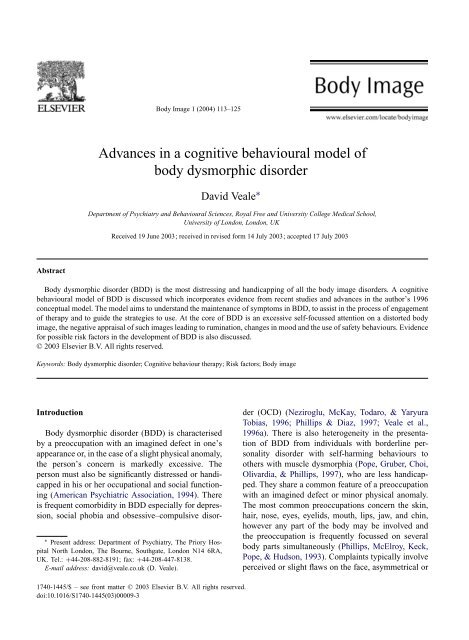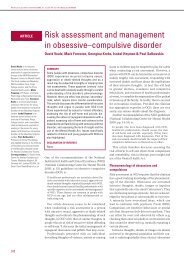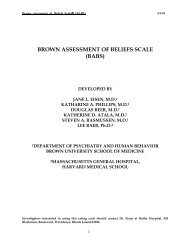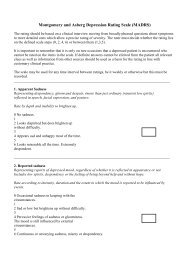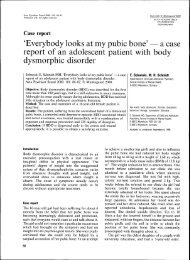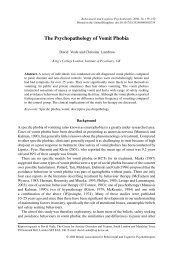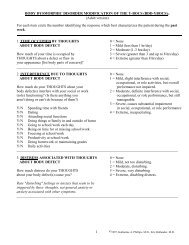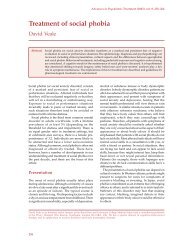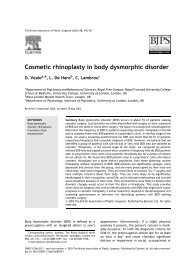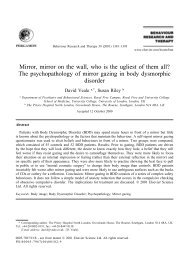Advances in a cognitive behavioural model of body ... - Dr David Veale
Advances in a cognitive behavioural model of body ... - Dr David Veale
Advances in a cognitive behavioural model of body ... - Dr David Veale
You also want an ePaper? Increase the reach of your titles
YUMPU automatically turns print PDFs into web optimized ePapers that Google loves.
Body Image 1 (2004) 113–125<strong>Advances</strong> <strong>in</strong> a <strong>cognitive</strong> <strong>behavioural</strong> <strong>model</strong> <strong>of</strong><strong>body</strong> dysmorphic disorder<strong>David</strong> <strong>Veale</strong> ∗Department <strong>of</strong> Psychiatry and Behavioural Sciences, Royal Free and University College Medical School,University <strong>of</strong> London, London, UKReceived 19 June 2003; received <strong>in</strong> revised form 14 July 2003; accepted 17 July 2003AbstractBody dysmorphic disorder (BDD) is the most distress<strong>in</strong>g and handicapp<strong>in</strong>g <strong>of</strong> all the <strong>body</strong> image disorders. A <strong>cognitive</strong><strong>behavioural</strong> <strong>model</strong> <strong>of</strong> BDD is discussed which <strong>in</strong>corporates evidence from recent studies and advances <strong>in</strong> the author’s 1996conceptual <strong>model</strong>. The <strong>model</strong> aims to understand the ma<strong>in</strong>tenance <strong>of</strong> symptoms <strong>in</strong> BDD, to assist <strong>in</strong> the process <strong>of</strong> engagement<strong>of</strong> therapy and to guide the strategies to use. At the core <strong>of</strong> BDD is an excessive self-focussed attention on a distorted <strong>body</strong>image, the negative appraisal <strong>of</strong> such images lead<strong>in</strong>g to rum<strong>in</strong>ation, changes <strong>in</strong> mood and the use <strong>of</strong> safety behaviours. Evidencefor possible risk factors <strong>in</strong> the development <strong>of</strong> BDD is also discussed.© 2003 Elsevier B.V. All rights reserved.Keywords: Body dysmorphic disorder; Cognitive behaviour therapy; Risk factors; Body imageIntroductionBody dysmorphic disorder (BDD) is characterisedby a preoccupation with an imag<strong>in</strong>ed defect <strong>in</strong> one’sappearance or, <strong>in</strong> the case <strong>of</strong> a slight physical anomaly,the person’s concern is markedly excessive. Theperson must also be significantly distressed or handicapped<strong>in</strong> his or her occupational and social function<strong>in</strong>g(American Psychiatric Association, 1994). Thereis frequent comorbidity <strong>in</strong> BDD especially for depression,social phobia and obsessive–compulsive disor-∗ Present address: Department <strong>of</strong> Psychiatry, The Priory HospitalNorth London, The Bourne, Southgate, London N14 6RA,UK. Tel.: +44-208-882-8191; fax: +44-208-447-8138.E-mail address: david@veale.co.uk (D. <strong>Veale</strong>).der (OCD) (Neziroglu, McKay, Todaro, & YaryuraTobias, 1996; Phillips & Diaz, 1997; <strong>Veale</strong> et al.,1996a). There is also heterogeneity <strong>in</strong> the presentation<strong>of</strong> BDD from <strong>in</strong>dividuals with borderl<strong>in</strong>e personalitydisorder with self-harm<strong>in</strong>g behaviours toothers with muscle dysmorphia (Pope, Gruber, Choi,Olivardia, & Phillips, 1997), who are less handicapped.They share a common feature <strong>of</strong> a preoccupationwith an imag<strong>in</strong>ed defect or m<strong>in</strong>or physical anomaly.The most common preoccupations concern the sk<strong>in</strong>,hair, nose, eyes, eyelids, mouth, lips, jaw, and ch<strong>in</strong>,however any part <strong>of</strong> the <strong>body</strong> may be <strong>in</strong>volved andthe preoccupation is frequently focussed on several<strong>body</strong> parts simultaneously (Phillips, McElroy, Keck,Pope, & Hudson, 1993). Compla<strong>in</strong>ts typically <strong>in</strong>volveperceived or slight flaws on the face, asymmetrical or1740-1445/$ – see front matter © 2003 Elsevier B.V. All rights reserved.doi:10.1016/S1740-1445(03)00009-3
114 D. <strong>Veale</strong> / Body Image 1 (2004) 113–125disproportionate <strong>body</strong> features, th<strong>in</strong>n<strong>in</strong>g hair, acne,wr<strong>in</strong>kles, scars, vascular mark<strong>in</strong>gs, and pallor, or rudd<strong>in</strong>ess<strong>of</strong> complexion. Sometimes the compla<strong>in</strong>t isextremely vague or amounts to no more than a generalperception <strong>of</strong> ugl<strong>in</strong>ess. BDD is characterised by timeconsum<strong>in</strong>g behaviours such as mirror gaz<strong>in</strong>g, compar<strong>in</strong>gparticular features to those <strong>of</strong> others, excessivecamouflage, sk<strong>in</strong>-pick<strong>in</strong>g, and reassurance seek<strong>in</strong>g.There is usually avoidance <strong>of</strong> social situations and<strong>of</strong> <strong>in</strong>timacy. Alternatively such situations are enduredwith the use <strong>of</strong> alcohol, illegal substances or safetybehaviours similar to social phobia.The prevalence rate <strong>of</strong> BDD <strong>in</strong> the community isreported as 0.7% <strong>in</strong> two studies (Faravelli et al., 1997;Otto, Wilhelm, Cohen, & Harlow, 2001) with a higherprevalence <strong>of</strong> milder cases <strong>in</strong> adolescents and youngadults (Bohne et al., 2002). The prevalence <strong>of</strong> BDDis about 5% <strong>in</strong> a cosmetic surgery sett<strong>in</strong>g (Sarwer,Wadden, Pertschuk, & Whitaker, 1998) and 12% <strong>in</strong>a dermatology cl<strong>in</strong>ic (Phillips, Dufresne, Wilkel, &Vittorio, 2000). Surveys <strong>of</strong> BDD patients attend<strong>in</strong>ga psychiatric cl<strong>in</strong>ic tend to show an equal sex <strong>in</strong>cidenceand sufferers are usually s<strong>in</strong>gle or separated(Neziroglu & Yaryura-Tobias, 1993; Phillips & Diaz,1997; Phillips et al., 1993; <strong>Veale</strong> et al., 1996a). <strong>Veale</strong>et al. (1996a) found a greater preponderance <strong>of</strong> womenbut this may be because <strong>of</strong> a referral bias. It is also possiblethat, <strong>in</strong> the community, while more women are affectedoverall, a greater proportion experience mildersymptoms.Although the age <strong>of</strong> onset <strong>of</strong> BDD is dur<strong>in</strong>g adolescence,patients are usually diagnosed 10–15 years later(Phillips, 1991; Phillips & Diaz, 1997; <strong>Veale</strong> et al.,1996a). Patients may be secretive because they mayth<strong>in</strong>k they will be viewed as va<strong>in</strong> or narcissistic. Theyare therefore more likely to present to mental healthpractitioners with symptoms <strong>of</strong> depression or socialanxiety unless they are specifically questioned aboutsymptoms <strong>of</strong> BDD. BDD patients are the most distressedand handicapped <strong>of</strong> all the <strong>body</strong> image disorderswith a high rate <strong>of</strong> depression and suicide or “doit yourself” (DIY) cosmetic surgery. Phillips (2000)used a quality <strong>of</strong> life measure and found a degree <strong>of</strong>distress that is worse than that <strong>of</strong> depression, diabetesor bipolar disorder.BDD is probably best conceptualised as hav<strong>in</strong>g bothquantitative and qualitative differences from normal<strong>body</strong> dissatisfaction and <strong>body</strong> image. For example, thedegree <strong>of</strong> importance attached to one’s appearance <strong>in</strong>def<strong>in</strong><strong>in</strong>g one’s self might be at the extreme end <strong>of</strong>a normal dimension. However, the distorted imageryexperienced by some BDD patients has a more qualitativedifference to normal <strong>body</strong> image.A <strong>cognitive</strong> <strong>behavioural</strong> <strong>model</strong> <strong>of</strong> BDDThere are similar features <strong>in</strong> psychopathology <strong>of</strong>BDD with OCD and social phobia, with frequent comorbidity.It is not therefore surpris<strong>in</strong>g that a <strong>cognitive</strong><strong>behavioural</strong> <strong>model</strong> <strong>of</strong> BDD described below hassome overlap with that <strong>of</strong> social phobia (Clark &Wells, 1995), OCD (Salkovskis, 1999) and health anxiety(Warwick & Salkovskis, 1990) which <strong>in</strong>fluence Iwould like to acknowledge. A <strong>model</strong> for BDD needsto focus on features, which are unique to BDD. Onesuch feature is the relationship with reflective surfacessuch as mirrors or old photos, which acts a trigger forthe symptoms. The <strong>model</strong> has some overlap with a<strong>cognitive</strong> <strong>behavioural</strong> <strong>model</strong> <strong>of</strong> <strong>body</strong> image developedby Cash and Pruz<strong>in</strong>sky (2002) which is most commonlyapplied to dissatisfaction for <strong>body</strong> weight andshape <strong>in</strong> a non-psychiatric population.Cognitive <strong>behavioural</strong> <strong>model</strong>s are relevant for answer<strong>in</strong>gquestions about the ma<strong>in</strong>tenance <strong>of</strong> symptoms.For example, why does an <strong>in</strong>dividual with BDD“see” a grossly distorted <strong>body</strong> image <strong>in</strong> a mirror whenothers view the person as genu<strong>in</strong>ely attractive and contradicttheir views? Furthermore, the <strong>model</strong> needs tobe understood by a patient; to provide an alternativeexplanation for their experience; to assist <strong>in</strong> the process<strong>of</strong> engagement and to guide the strategies to use<strong>in</strong> therapy. For each section <strong>of</strong> the <strong>model</strong>, I will discussthe theory, the evidence for the <strong>model</strong> so far andthe cl<strong>in</strong>ical implications <strong>in</strong> therapy. I will discuss putativerisk factors for the development <strong>of</strong> BDD <strong>in</strong> thesecond half <strong>of</strong> the article.The self as an aesthetic objectThe self as an aesthetic object refers to the experience<strong>of</strong> extreme self-consciousness and self-focussedattention on a distorted image. It is proposed thatthe cycle beg<strong>in</strong>s when an external representation <strong>of</strong>the person’s appearance (e.g. look<strong>in</strong>g <strong>in</strong> a mirror)
D. <strong>Veale</strong> / Body Image 1 (2004) 113–125 115Trigger (externalrepresentation<strong>of</strong> appearance)Selective attentionNegative appraisal <strong>of</strong><strong>in</strong>ternal <strong>body</strong> imageProcess<strong>in</strong>g <strong>of</strong> selfas an aesthetic objectSafety behavioursto camouflage andalter appearanceMood (disgust& depression)Rum<strong>in</strong>ation onugl<strong>in</strong>ess & compareto idealFig. 1. A <strong>cognitive</strong> <strong>behavioural</strong> <strong>model</strong> <strong>of</strong> BDD.activates a distorted mental image (Fig. 1). A mentalimage is def<strong>in</strong>ed as “contents <strong>of</strong> consciousness thatpossess sensory qualities, as opposed to those that arepurely verbal or abstract” (Horowitz, 1970). The process<strong>of</strong> selective attention has the effect <strong>of</strong> <strong>in</strong>creas<strong>in</strong>gawareness <strong>of</strong> the image and <strong>of</strong> specific features with<strong>in</strong>the image. The image is used to construct how the personlooks <strong>in</strong> the mirror and provide <strong>in</strong>formation abouthow he or she appears to others (also referred to as theprocess <strong>of</strong> “m<strong>in</strong>d read<strong>in</strong>g”). The evidence for imagery<strong>in</strong> BDD so far is a descriptive study that compared18 BDD patients with 18 healthy controls us<strong>in</strong>g asemi-structured <strong>in</strong>terview and questionnaires (Osman,Cooper, Hackmann, & <strong>Veale</strong>, 2003). BDD and controlswere just as likely to experience spontaneous images<strong>of</strong> their appearance (like Fig. 1). However BDDpatients were more likely to rate the images as significantlymore negative, recurrent and vivid than normalcontrols. Images <strong>in</strong> BDD patients were more distortedand the “defective” features took up a greater proportion<strong>of</strong> the whole image. They typically reported visualimages, which were sometimes associated with othersensory modalities (e.g. organic sensations <strong>of</strong> hungeror fatigue). Of particular significance is that the imageswere more likely to be viewed from an observer perspectivecompared to a field perspective, similar to af<strong>in</strong>d<strong>in</strong>g <strong>in</strong> social phobia (Hackmann, Surawy, & Clark,1998). An observer perspective consists <strong>of</strong> the <strong>in</strong>dividuallook<strong>in</strong>g at him or her self from another person’sperspective. A. field perspective consists <strong>of</strong> an <strong>in</strong>dividualon the <strong>in</strong>side look<strong>in</strong>g out <strong>of</strong> one’s own <strong>body</strong>.Stopa (2003) has noted that an observer perspectiveis not abnormal per se but is more likelyto occur with trauma and false memories. However,BDD and social phobic patients may use theobserver perspective <strong>in</strong>itially <strong>in</strong> order to distancethemselves and avoid emotion associated with negativeevaluative experiences. The observer perspectivemay therefore become a ma<strong>in</strong>ta<strong>in</strong><strong>in</strong>g factor throughcont<strong>in</strong>ued avoidance <strong>of</strong> emotion. An external perspectivemay <strong>in</strong>crease its “authority” and <strong>in</strong>creasethe tendency to make <strong>in</strong>ternal attributions about anevent.It is proposed that activation <strong>of</strong> imagery is associatedwith an <strong>in</strong>creased self-focussed attention. Selffocussedattention is def<strong>in</strong>ed as an awareness<strong>of</strong> self-referent, <strong>in</strong>ternally generated <strong>in</strong>formation(Ingram, 1990). Self-referent <strong>in</strong>formation can <strong>in</strong>cludea wide range <strong>of</strong> stimuli from an awareness <strong>of</strong>sensations, thoughts, images, or emotions from past
116 D. <strong>Veale</strong> / Body Image 1 (2004) 113–125memories that <strong>in</strong>fluence the self <strong>in</strong> the present. It istherefore a non-specific process that occurs <strong>in</strong> a widerange <strong>of</strong> disorders from social phobia to schizophrenia.The degree <strong>of</strong> self-focussed attention is likely tobe related to the severity <strong>of</strong> the symptoms and degree<strong>of</strong> preoccupation (Woodruff-Borden, Brothers,& Lister, 2001). It is proposed that <strong>in</strong> severe cases<strong>of</strong> BDD the attentional capacity is taken over by thedistorted image and negative appraisal. Furthermore,the system may be so rigid that it is unable to switchto any external <strong>in</strong>formation about one’s appearance.In less severe cases, there appears some attentionalcapacity to external <strong>in</strong>formation so that the imagemay be less stable and associated with doubts abouthow the person appears to others. In this case, the<strong>in</strong>dividual may feel driven by a need to know exactlyhow they look. The person might be rewarded onlywith certa<strong>in</strong>ty whilst he is look<strong>in</strong>g <strong>in</strong> a mirror, whichis then re<strong>in</strong>forced. However the longer a person looks<strong>in</strong> front <strong>of</strong> a mirror, the more self-conscious he becomes,the worse he feels and the more it re<strong>in</strong>forceshis or her view <strong>of</strong> be<strong>in</strong>g ugly and defective. Patientsbecome genu<strong>in</strong>ely confused about how their appearancemight alter from day to day or hour to hour.However, this might occur <strong>in</strong> the context <strong>of</strong> moodchanges and occasional re<strong>in</strong>forcement <strong>of</strong> feel<strong>in</strong>g better<strong>in</strong> a particular light or a “good” mirror whenthere is less self-focussed attention. Hence patientmay believe that <strong>in</strong> every mirror they look, they see adifferent image (<strong>Veale</strong> & Riley, 2001).Increased self-focussed attention on physical appearance<strong>in</strong>creases the specificity for BDD, but <strong>in</strong>dividualswith a disfigurement or an eat<strong>in</strong>g disorderwill also be more self-conscious about their appearance.The process <strong>of</strong> selective attention appears to befocussed on specific features <strong>of</strong> an image lead<strong>in</strong>g toa heightened awareness and relative magnification <strong>of</strong>certa<strong>in</strong> aspects, which contributes to the development<strong>of</strong> a distorted <strong>body</strong> image. One might predict thatselective attention would lead to <strong>in</strong>creased accuracy<strong>of</strong> certa<strong>in</strong> aspects <strong>of</strong> one’s <strong>body</strong>. For example, Jerome(1992) found that patients on a wait<strong>in</strong>g list for cosmeticrh<strong>in</strong>oplasty (but not diagnosed as BDD) weremore accurate than healthy controls <strong>in</strong> estimat<strong>in</strong>g thesize <strong>of</strong> their nose. This work needs to be replicated<strong>in</strong> BDD patients who may be selectively attend<strong>in</strong>gto a distorted <strong>body</strong> image and may therefore be lessaccurate.The role <strong>of</strong> imagery and self-focussed attention hassignificant implications for therapy. First, a discussion<strong>of</strong> the role <strong>of</strong> imagery, the l<strong>in</strong>k with early experiencesand the mean<strong>in</strong>g attached to the image will all assist<strong>in</strong> the process <strong>of</strong> engagement. First, the therapist andpatient can talk about the “image” as the problemrather than the person’s appearance. This can lead toa discussion about the way perception is constructedand is not just a picture on the back <strong>of</strong> the ret<strong>in</strong>athat is faithfully reproduced. Second, when assess<strong>in</strong>gpatients, more negative self-beliefs can be accessedvia images and from earlier memories than via verbalthoughts (Osman et al., 2003). Third there are a number<strong>of</strong> techniques for modify<strong>in</strong>g the mean<strong>in</strong>g <strong>of</strong> theimage by historical reviews or rescript<strong>in</strong>g an image especiallyfor teas<strong>in</strong>g, bully<strong>in</strong>g and sexual trauma (Arntz& Weertman, 1999; Hackmann, 1998) or the beliefsabout the imagery (Layden, Newman, Freeman,& Morse, 1993; Smucker & Niederee, 1995). Lastly,cl<strong>in</strong>icians may f<strong>in</strong>d it helpful to explore the role <strong>of</strong>the observer perspective. For example, is emotionmore or less <strong>in</strong>tense with observer or field perspectiveimages? (Stopa, 2003).The <strong>model</strong> also suggests that techniques that helpto tra<strong>in</strong> <strong>in</strong>dividuals to <strong>in</strong>crease the proportion <strong>of</strong> attentionaway from self-referent <strong>in</strong>formation towardstasks or the environment will be <strong>of</strong> assistance. Thisstrategy has been described for social anxiety (Bogels,Mulkens, & De Jong, 1997) or health anxiety (Wells,1990, 2000). The pr<strong>in</strong>ciple <strong>of</strong> <strong>in</strong>creas<strong>in</strong>g attention ona task such as shav<strong>in</strong>g or comb<strong>in</strong>g one’s hair can alsobe applied to mirror retra<strong>in</strong><strong>in</strong>g (<strong>Veale</strong> & Riley, 2001)or rout<strong>in</strong>e activities such as walk<strong>in</strong>g down a street andbecom<strong>in</strong>g more aware <strong>of</strong> the environment from a fieldperspective.Negative appraisal <strong>of</strong> <strong>body</strong> imageThe next step is the negative appraisal and aestheticjudgement <strong>of</strong> the image, by activation <strong>of</strong> assumptionsand values about the importance <strong>of</strong> appearance. InBDD, appearance has become over-identified with theself and at the centre <strong>of</strong> a “personal doma<strong>in</strong>” (<strong>Veale</strong>,2002). The term, “personal doma<strong>in</strong>”, was first usedby (Beck, 1976) to describe the way a person attachesmean<strong>in</strong>g to events or objects around them. At the centre<strong>of</strong> a personal doma<strong>in</strong> are a person’s characteristics,
D. <strong>Veale</strong> / Body Image 1 (2004) 113–125 117his physical attributes, his goals and values. Clusteredaround are the animate and <strong>in</strong>animate objects <strong>in</strong> whichhe has an <strong>in</strong>vestment such as his family, friends, andpossessions. An idealised value occurs when one <strong>of</strong>the values develops <strong>in</strong>to such over-rid<strong>in</strong>g importancethat it def<strong>in</strong>es the “self” or identity <strong>of</strong> the <strong>in</strong>dividualor becomes the very centre <strong>of</strong> a personal doma<strong>in</strong>. Theidealised value <strong>in</strong> BDD is usually the importance <strong>of</strong>appearance <strong>of</strong> certa<strong>in</strong> features but other values may<strong>in</strong>clude social acceptance, perfectionism, symmetry oryouth. Such values will re<strong>in</strong>force process<strong>in</strong>g <strong>of</strong> theself as an aesthetic object (and <strong>in</strong> social situations asa social object (Clark & Wells, 1995). Without theseidealised values, it might be possible to adapt to a distorted<strong>body</strong> image <strong>in</strong> the way that some <strong>in</strong>dividualswith a disfigurement may accept themselves and becomeless self-conscious (Partridge, 1990).The conditional assumptions and rules about one’sappearance will be driven by the values about the importance<strong>of</strong> appearance to one’s identity. Typical assumptions<strong>in</strong>clude: “If I am unattractive, then life isnot worth liv<strong>in</strong>g”, “If I am defective, then I will bealone all my life” or “I can only do someth<strong>in</strong>g when Ifeel comfortable about my appearance” (<strong>Veale</strong> et al.,1996a). Geremia and Neziroglu (2001) have notedother assumptions such as “If I looked better then mywhole life will be better”, “How I feel about myselfas a person is related to how I feel about how I look”.Typical core beliefs that are activated are based on(a) be<strong>in</strong>g a failure or generally <strong>in</strong>adequate; (b) be<strong>in</strong>gworthless; (c) be<strong>in</strong>g ugly, repulsive or abnormal; (d)be<strong>in</strong>g unlovable or unacceptable; (e) be<strong>in</strong>g rejected byothers and be<strong>in</strong>g alone for the rest <strong>of</strong> their life (Osmanet al., 2003). Most <strong>of</strong> these core beliefs are not specificto BDD but are common themes <strong>in</strong> depressionand personality disorders. The <strong>model</strong> predicts that activation<strong>of</strong> the negative appraisals will have a negativefeedback and will <strong>in</strong>crease self-focussed attention onthe image.The degree <strong>of</strong> <strong>in</strong>vestment on appearance-relatedself-schemas has also been explored by Cash andPruz<strong>in</strong>sky (2002) and Cash, Melnyk, and Hrabosky(<strong>in</strong> press) who have developed and revised the appearanceschemas <strong>in</strong>ventory (ASI) to assess the degree <strong>of</strong>importance attached to one’s <strong>body</strong> image. The ASIhas two factors—the person’s self-evaluative saliencewhich measures the degree to which an <strong>in</strong>dividualdef<strong>in</strong>es themselves by their physical appearance anda motivational salience—the extent to which theyattend to their appearance and engage <strong>in</strong> appearancemanagement behaviours. Items for the self-evaluativeconcerns <strong>in</strong>clude: “What I look like is an importantpart <strong>of</strong> who I am” or “My appearance is responsiblefor much <strong>of</strong> what’s happened to me <strong>in</strong> my life”. The<strong>in</strong>strument has not yet been studied <strong>in</strong> BDD and doesnot cover specific assumptions or rules such as thosedescribed above.In common with other mood disorders, such appraisalswill contribute to the bias towards beliefsthat are confirmatory. For example, compliments areeasily dismissed <strong>in</strong> a process <strong>of</strong> “discount<strong>in</strong>g thepositive”. Examples <strong>in</strong>clude “They are say<strong>in</strong>g it to benice to me” or “They have to love me because theyare my parents”. Alternatively neutral comments maybe turned <strong>in</strong>to negative and be self-referential.Therapy <strong>in</strong>volves (a) identify<strong>in</strong>g and help<strong>in</strong>g <strong>in</strong>dividualsto question the mean<strong>in</strong>g <strong>of</strong> the defectiveness(not the defect itself); (b) challeng<strong>in</strong>g the assumptionsabout be<strong>in</strong>g defective; (c) modify<strong>in</strong>g values by a pragmaticapproach (e.g. question<strong>in</strong>g their functional cost)(<strong>Veale</strong>, 2002); (d) reduc<strong>in</strong>g the importance <strong>of</strong> the appearance<strong>in</strong> def<strong>in</strong><strong>in</strong>g the self (<strong>Dr</strong>yden, 1998; Lazarus,1977); (e) reverse role-play to strengthen an alternativebelief <strong>in</strong> which patients can practice argu<strong>in</strong>g thecase for their alternative belief whilst the therapist arguesthe case for the old beliefs or values (Cromarty& Marks, 1995). This is standard <strong>cognitive</strong> therapybut cl<strong>in</strong>ical experience suggests that such strategiesare better used later <strong>in</strong> therapy when an <strong>in</strong>dividual isengaged <strong>in</strong> the <strong>model</strong>, is us<strong>in</strong>g less safety behavioursand has become more functional.Rum<strong>in</strong>ation and comparison with idealBDD is def<strong>in</strong>ed as a “preoccupation” with many<strong>in</strong>dividuals report<strong>in</strong>g that it is on their m<strong>in</strong>d mosthours <strong>of</strong> the day. Some <strong>of</strong> the <strong>cognitive</strong> processes thatdeterm<strong>in</strong>e a preoccupation can be expla<strong>in</strong>ed by thefixed attentional capacity on the distorted imagery andnegative appraisal described above. However little isknown <strong>in</strong> BDD about other <strong>cognitive</strong> processes thatcontribute to the nature <strong>of</strong> the “preoccupation” and thesimilarities or differences to worry or an obsession. Forexample, the process might <strong>in</strong>clude meta-cognitions;comparisons with an ideal <strong>in</strong>ternal image or with
118 D. <strong>Veale</strong> / Body Image 1 (2004) 113–125other <strong>in</strong>dividuals, and anticipatory worry about futureevents.Theories <strong>of</strong> social comparison (Fest<strong>in</strong>ger, 1954) orsocial rank<strong>in</strong>g (Allan & Gilbert, 1995; Gilbert, Price,& Allan, 1995) have been applied to <strong>body</strong> dissatisfaction(He<strong>in</strong>berg & Thompson, 1992). The theoryassumes that <strong>in</strong>dividuals compare themselves withothers and engage <strong>in</strong> upward comparisons or choose<strong>in</strong>appropriate comparison targets with unrealistic ideals.In BDD, the appearance comparison appears tobe on specific feature(s) that are regarded as defective.Those who view their feature as very unattractivemay desire to just blend <strong>in</strong> with an average. A m<strong>in</strong>oritywho view their feature as average might desire anunrealistic standard or perfectionism. When <strong>in</strong> front<strong>of</strong> a mirror the comparison may be another image.Alternatively the comparisons may be with an oldphoto <strong>of</strong> him or her self or a picture <strong>in</strong> the media. Insocial situations, the comparison is usually <strong>of</strong> peersthe same age and sex. The constant comparison hasa negative feedback on <strong>in</strong>creas<strong>in</strong>g negative appraisaland self-focussed attention on the image.The evidence for repeated comparisons <strong>in</strong> BDD islimited but we have some data from a study basedon self-discrepancy theory (<strong>Veale</strong>, K<strong>in</strong>derman, Riley,& Lambrou, 2003). Self-discrepancy theory proposesthree basic doma<strong>in</strong>s <strong>of</strong> self-beliefs: (a) the actualself—the <strong>in</strong>dividual’s representation <strong>of</strong> the attributesthat someone (self or significant other) believes the<strong>in</strong>dividual actually possesses; (b) the ideal self—the<strong>in</strong>dividual’s representation <strong>of</strong> the attributes that someone(self or significant other) would ideally hopethe <strong>in</strong>dividual to possess; (c) the should or oughtself—the <strong>in</strong>dividual’s representation <strong>of</strong> the attributesthat someone (self or significant other) believes the<strong>in</strong>dividual ought as a sense <strong>of</strong> duty or moral obligationto possess. The ideal and should selves arereferred to as self-guides. It is assumed that a discrepancybetween the actual self and the self-guidesdeterm<strong>in</strong>e the <strong>in</strong>dividual’s vulnerability to negativeemotional states (Higg<strong>in</strong>s, 1987). For example, <strong>in</strong> aself-actual: self-ideal discrepancy, the <strong>in</strong>dividual isvulnerable to dejection-related emotions (e.g. depression,<strong>in</strong>ternal shame), result<strong>in</strong>g from the appraisalthat his or her hopes and aspirations are unfulfilledwith the absence <strong>of</strong> positive re<strong>in</strong>forcement. In aself-actual: other-should discrepancy, the <strong>in</strong>dividualis vulnerable to anxiety result<strong>in</strong>g from the appraisalthat one has been unable to achieve one’s responsibilitiesand is therefore liable for punishment (theanticipated presence <strong>of</strong> negative outcomes seen <strong>in</strong>social phobia). <strong>Veale</strong> et al. (2003) explored the role<strong>of</strong> self-discrepancy theory <strong>in</strong> 72 BDD patients and42 controls who completed a modified version <strong>of</strong>the selves questionnaire (Higg<strong>in</strong>s, Bond, Kle<strong>in</strong>, &Strauman, 1986) requir<strong>in</strong>g them to list and rate physicalcharacteristics accord<strong>in</strong>g to the follow<strong>in</strong>g standpo<strong>in</strong>ts:(a) self-actual; (b) self-ideal; (c) self-should;(d) other-actual; and (e) other-ideal. Compared tocontrols, BDD patients displayed significant greaterdiscrepancies between their self-actual and both theirself-ideal and self-should. There were no significantdiscrepancies <strong>in</strong> BDD patients compared to controlshowever, between their self-actual and other-actualor other-ideal doma<strong>in</strong>s. The results suggest that BDDpatients have their own ideal as to how they shouldlook and are more concerned with a failure to achievetheir own aesthetic standard than with be<strong>in</strong>g punishedfor fail<strong>in</strong>g to achieve the ideals <strong>of</strong> others. Asimilar <strong>in</strong>strument (the Body Image Ideals Questionnaire)has been developed by Cash and Szymanski(1995) to assess evaluative <strong>body</strong> image and discrepancybetween self-perceived physical attributes and<strong>in</strong>ternalised standards or ideals from one’s own and asignificant other’s standpo<strong>in</strong>t. In addition, the degree<strong>of</strong> importance attached to each <strong>of</strong> these discrepanciesis assessed so that <strong>body</strong> image satisfaction dependson (a) the extent to which <strong>body</strong> image is matchedwith ideals; (b) the importance attached to hav<strong>in</strong>g oratta<strong>in</strong><strong>in</strong>g those ideals. The BIQ is based upon 10 physicalcharacteristics <strong>in</strong>clud<strong>in</strong>g height, weight, chestsize, physical strength or co-ord<strong>in</strong>ation which are notusually relevant for most <strong>in</strong>dividuals with BDD whoare more likely to focus on aspects <strong>of</strong> their face. Thestrength <strong>of</strong> the BIQ is that it assesses both discrepancyand degree <strong>of</strong> importance attached to the discrepancy.Further data on <strong>cognitive</strong> processes and appearancecomparison <strong>in</strong> BDD were provided by a study explor<strong>in</strong>gattention to emotional faces. Anson, <strong>Veale</strong>, andDe Silva (2003) compared 25 BDD patients with 17normal controls with a modified dot probe paradigmorig<strong>in</strong>ally used by Mansell, Clark, Ehlers, and Chen(1999) and Mansell, Clark, and Ehlers (2003). Inthestudy by Mansell et al. (1999), high and low sociallyanxious <strong>in</strong>dividuals (without BDD) were briefly presentedwith pictures conta<strong>in</strong><strong>in</strong>g a face paired with a
D. <strong>Veale</strong> / Body Image 1 (2004) 113–125 119household object. The faces were negative, neutral orhappy. Each face–object pair was followed by one <strong>of</strong>two letters <strong>in</strong> a location correspond<strong>in</strong>g to the centre<strong>of</strong> one <strong>of</strong> the pictures, and participants had to <strong>in</strong>dicateas quickly as possible which letter they saw. Theassumption is <strong>of</strong> a faster reaction time to letters thatfollow the location <strong>of</strong> the picture (i.e. face or object)to which subject was attend<strong>in</strong>g. Mansell et al. (1999)found that high socially anxious <strong>in</strong>dividuals showedan attentional bias away from emotional (negative andpositive) faces, but only when tested under conditions<strong>of</strong> anticipatory social threat.In the study by Anson et al. (2003), the anticipatorythreat <strong>in</strong>duction was modified to <strong>in</strong>clude a BDDthreat and no threat condition. The threat condition <strong>in</strong>volvedan appearance-related social evaluative threat,<strong>in</strong> which subjects were told that they would be videorecorded, and would then observe volunteers watch<strong>in</strong>gthe video (although this did not actually happen).The authors found that attention to faces as a wholewas significantly greater <strong>in</strong> BDD patients compared tocontrols <strong>in</strong> the absence <strong>of</strong> threat, with the effect be<strong>in</strong>gparticularly prom<strong>in</strong>ent for neutral and positive faces.Under anticipatory threat, attention to neutral and positivefaces was suppressed, while attention to negativefaces rema<strong>in</strong>ed unchanged. This effect was <strong>in</strong> contrastto the results obta<strong>in</strong>ed by Mansell et al. <strong>in</strong> high sociallyanxious patients. Anson et al. (2003) hypothesised that<strong>in</strong> the absence <strong>of</strong> threat, BDD patients may have beencompar<strong>in</strong>g themselves to faces, especially neutral andpositive images, which they may have rated as moreattractive, or relevant <strong>in</strong> terms <strong>of</strong> comparison target.However, appearance comparison is likely to be a potentiallyanxiety-provok<strong>in</strong>g process, which may havebeen activated under conditions <strong>of</strong> threat, lead<strong>in</strong>g toreduction <strong>in</strong> attention to neutral and positive faces. Afurther possible explanation is that social evaluativethreat may result <strong>in</strong> reduced attention to faces belong<strong>in</strong>gto particular groups <strong>of</strong> people whom BDD patientsare most concerned about <strong>in</strong> terms <strong>of</strong> negative appearanceevaluation.Cl<strong>in</strong>ically a few patients appear to have little orno social evaluative concerns and would still be distressedand look<strong>in</strong>g <strong>in</strong> mirror if they were left alone ona desert island. Most regard social evaluative concernsas an additional burden and would be less distressed <strong>in</strong>a hypothetical situation <strong>of</strong> be<strong>in</strong>g left alone on a desertisland. Some <strong>in</strong>dividuals have almost exclusively socialevaluative concerns and believe they would haveno symptoms <strong>of</strong> BDD <strong>in</strong> the hypothetical situation <strong>of</strong>be<strong>in</strong>g left alone on a desert island. This reflects theheterogeneity and complexity <strong>of</strong> BDD and the importance<strong>of</strong> an <strong>in</strong>dividual formulation <strong>in</strong> treatment plann<strong>in</strong>g.The importance <strong>of</strong> this part <strong>of</strong> the <strong>model</strong> is thatappearance comparisons are another factor that ma<strong>in</strong>ta<strong>in</strong>sdistorted negative appraisals and imagery <strong>in</strong> anegative feedback loop. Furthermore, the attention is<strong>of</strong>ten selective and unrepresentative and likely to <strong>in</strong>terferewith process<strong>in</strong>g <strong>of</strong> other external <strong>in</strong>formation.One goal <strong>of</strong> therapy therefore <strong>in</strong>volves resist<strong>in</strong>g thefrequent comparison and rat<strong>in</strong>g <strong>of</strong> one’s appearanceaga<strong>in</strong>st others.EmotionEmotions <strong>in</strong> BDD are complex and will dependupon the exact appraisal <strong>of</strong> the situation and event. Theemotions <strong>in</strong>clude (a) <strong>in</strong>ternal shame (or self-disgust)when the <strong>in</strong>dividual compares and ranks his or herappearance as lower than others; (b) external shameand anticipatory social anxiety based on judgementsabout how others are likely to scrut<strong>in</strong>ise, humiliateor reject them; (c) depression and hopelessness atthe person’s failure to reach his or her aesthetic standard,perhaps liv<strong>in</strong>g <strong>in</strong> social isolation, <strong>in</strong>ter-personalconflicts and deficits <strong>in</strong> relationships; (d) anger andfrustration at oneself for damag<strong>in</strong>g his or her appearance(e.g. do it yourself surgery, sk<strong>in</strong>-pick<strong>in</strong>g); othersnot understand<strong>in</strong>g or agree<strong>in</strong>g with their concerns;not hav<strong>in</strong>g enough money to pay for cosmetic surgeryor not obta<strong>in</strong><strong>in</strong>g satisfaction <strong>in</strong> cosmetic surgery; (e)guilt at damag<strong>in</strong>g one’s appearance either by oneselfor seek<strong>in</strong>g cosmetic surgery. With the prom<strong>in</strong>ence <strong>of</strong>hopelessness and shame, it is not therefore surpris<strong>in</strong>gthat there is a high degree <strong>of</strong> comorbidity withdepression and risk <strong>of</strong> suicide (Phillips et al., 1993;<strong>Veale</strong> et al., 1996a,b). As <strong>in</strong> other areas, there isa negative feedback loop as <strong>in</strong>creases <strong>in</strong> emotionalarousal will tend to <strong>in</strong>crease the frequency or severity<strong>of</strong> negative appraisal <strong>of</strong> one’s <strong>body</strong> image and <strong>in</strong>creaseself-focussed attention. Symptoms <strong>of</strong> arousalare not normally targeted <strong>in</strong> CBT, but any strategythat improves mood or <strong>in</strong>creased tolerance to negativestates would theoretically decrease preoccupation andnegative appraisal. In this regard, there is evidence
120 D. <strong>Veale</strong> / Body Image 1 (2004) 113–125for the modest benefit <strong>of</strong> selective serotonergic reuptake<strong>in</strong>hibitor anti-depressants <strong>in</strong> two randomisedcontrolled trials (Phillips, 2002; Phillips, Albert<strong>in</strong>i, &Rasmussen, 2002) although the mechanism <strong>of</strong> theiraction is unknown. Of note is that patients with orwithout a delusional disorder did equally well withan SSRI and there is no evidence for the benefit <strong>of</strong>anti-psychotic medication alone <strong>in</strong> BDD.Safety behavioursBDD is frequently conceptualised as on the spectrum<strong>of</strong> OCD partly because <strong>of</strong> the similarities <strong>in</strong>psychopathology (e.g. “compulsive behaviours” suchas mirror check<strong>in</strong>g). This is <strong>in</strong>corporated <strong>in</strong> the mostwidely used outcome measure (Yale Brown ObsessiveCompulsive Scale modified for BDD (Phillipset al., 1997). I believe however, it is better to conceptualiseall the <strong>behavioural</strong> strategies to reduce the risk<strong>of</strong> danger <strong>in</strong> feared situations <strong>in</strong>clud<strong>in</strong>g escape andnon-repetitive behaviours used by BDD <strong>in</strong>dividualsas “safety behaviours” (Salkovskis, 1991, 1996) orfrom an evolutionary psychology perspective as “submissivebehaviours” (Allan & Gilbert, 1997; Gilbert,2000b; Harper, 1985). It is assumed that such learntbehaviours may have been adaptive <strong>in</strong> the past <strong>in</strong>certa<strong>in</strong> contexts.Traditionally safety behaviours for all anxiety disordersare actions with<strong>in</strong> situations designed to preventfeared catastrophes. The essence <strong>of</strong> a submissivebehaviour <strong>in</strong> a social situation is damage-limit<strong>in</strong>gself-presentations (Gilbert, 2000b) rather than acquisitiveones. Safety or submissive behaviours <strong>in</strong>clude(a) avoidance or active escape behaviours when theemotion is overwhelm<strong>in</strong>g; (b) subtle behaviours suchas camouflag<strong>in</strong>g to reduce scrut<strong>in</strong>y by others; (c) compulsivebehaviours that are repeated until the personfeels “comfortable” or “just right”. Safety behavioursare <strong>of</strong>ten idiosyncratic and have personal mean<strong>in</strong>g tothe <strong>in</strong>dividual. Thus one woman may be us<strong>in</strong>g excessivemake-up to camouflage facial sk<strong>in</strong>. Anotherwoman may be avoid<strong>in</strong>g make-up believ<strong>in</strong>g that itwould attract attention towards her. Safety behaviours<strong>in</strong> BDD are generally adapted by the <strong>in</strong>dividual to:(a) avoid th<strong>in</strong>k<strong>in</strong>g about a feature;(b) alter a feature;(c) camouflage a feature;(d) distract attention from a feature; or(e) reduce uncerta<strong>in</strong>ty or distress about an image.Examples <strong>of</strong> various safety behaviours are providedbelow.(a) A man who tore up all photos <strong>of</strong> himself to preventhim from th<strong>in</strong>k<strong>in</strong>g about the “wrong” impressionthat he was giv<strong>in</strong>g.(b) A man who had had three rh<strong>in</strong>oplasties but wasnow preoccupied with scarr<strong>in</strong>g from the first operation.(c) A woman who spent time us<strong>in</strong>g various beautytreatments to camouflage her face, which she believedto have numerous l<strong>in</strong>es and scars.(d) A woman who shaved <strong>of</strong> all the hair on her headand had a large tattoo to distract attention <strong>in</strong> publicaway from a “flaw” on her nose. This had the effect<strong>of</strong> <strong>in</strong>creas<strong>in</strong>g her self-consciousness and attract<strong>in</strong>gnegative evaluation <strong>of</strong> her appearance by others.(e) A man preoccupied with his nose who stood <strong>in</strong>front <strong>of</strong> a mirror and performed mental cosmeticsurgery on his nose until he felt “comfortable”.This is similar to a compulsive wash<strong>in</strong>g or check<strong>in</strong>g<strong>in</strong> OCD as the person is us<strong>in</strong>g problematiccriteria for the term<strong>in</strong>ation <strong>of</strong> a compulsion,namely, feel<strong>in</strong>g “comfortable” or “absolutelysure” (Richards & Salkovskis, 1995) or the “rightfeel<strong>in</strong>g” (Yaryura-Tobias & Neziroglu, 1997).The importance for the <strong>model</strong> is that there isanother negative feedback loop. Safety behavioursmay briefly decrease distress or uncerta<strong>in</strong>ty but arecounter-productive and <strong>in</strong>crease self-consciousness,preoccupation and negative appraisal. Furthermore,safety behaviours (a) <strong>in</strong>volve enormous mental effortand attention which means less capacity for external<strong>in</strong>formation; (b) <strong>of</strong>ten lead to further monitor<strong>in</strong>g (e.g.mirror check<strong>in</strong>g to determ<strong>in</strong>e if the camouflage is“work<strong>in</strong>g”); (c) may objectively make one’s appearanceworse (for example, sk<strong>in</strong>-pick<strong>in</strong>g); (d) <strong>in</strong>creaseattention by others to one’s appearance (for example,a person hold<strong>in</strong>g their hand up aga<strong>in</strong>st their face).In cl<strong>in</strong>ical practice, an idiosyncratic version <strong>of</strong> the<strong>model</strong> is drawn up with the patient which focuses ona specific episode <strong>of</strong> <strong>in</strong>creased worry about one’s appearance(e.g. a person look<strong>in</strong>g <strong>in</strong> a mirror <strong>in</strong> the hopethat he does not look as bad as he th<strong>in</strong>ks he does <strong>in</strong> his
D. <strong>Veale</strong> / Body Image 1 (2004) 113–125 121image). A <strong>behavioural</strong> experiment may be constructedto determ<strong>in</strong>e the effect <strong>of</strong> the safety behaviour on thedegree <strong>of</strong> preoccupation, self-consciousness and negativeappraisal. Suffice to say all safety behaviours area major ma<strong>in</strong>tenance factor <strong>in</strong> the preoccupation anddistress <strong>of</strong> BDD and much creativity may be requiredto help patients stop us<strong>in</strong>g their safety behaviours.Similarly, patients will require exposure to situationsavoided without their safety behaviours and with maximumattention on tasks (rather than the self).Risk factorsThe <strong>cognitive</strong> <strong>behavioural</strong> <strong>model</strong> described is onlyrelevant for factors that ma<strong>in</strong>ta<strong>in</strong> a distorted <strong>body</strong> image.As yet, only limited data are available on risk factorsfor the development <strong>of</strong> BDD and the f<strong>in</strong>al pathwaydescribed above. One <strong>of</strong> the most important challengesfor any epidemiological <strong>in</strong>vestigation <strong>in</strong> this area isdist<strong>in</strong>guish<strong>in</strong>g between risk factors that are specific toBDD and those that predispose to other disorders. Because<strong>of</strong> the similarity <strong>in</strong> phenomenology and reportedcomorbidity (Phillips, 1996; <strong>Veale</strong> et al., 1996a), BDDis regarded a be<strong>in</strong>g on the spectrum <strong>of</strong> either OCD(Hollander, 1993; Neziroglu & Yaryura-Tobias, 1993)or affective disorders (Phillips, McElroy, Hudson, &Pope, 1995). Therefore, any study on risk factors needsto <strong>in</strong>clude both non-cl<strong>in</strong>ical controls and those withdepression and OCD. The onset <strong>of</strong> BDD is <strong>in</strong> adolescenceand therefore particular attention will need tobe given to risk factors preced<strong>in</strong>g the onset. For example,not all <strong>in</strong>dividuals who have experience <strong>of</strong> be<strong>in</strong>gteased about their appearance develop BDD and oneaim <strong>of</strong> future research is to determ<strong>in</strong>e which factors (orcomb<strong>in</strong>ation <strong>of</strong> factors) predict future persistence <strong>of</strong>extreme self-consciousness so that <strong>in</strong>terventions maybe devised for those at risk. I will review some <strong>of</strong> thehypothesised risk factors especially dur<strong>in</strong>g childhoodand adolescence.Genetic factorsAs <strong>in</strong> most psychiatric disorders, genes are likelyto predispose an <strong>in</strong>dividual when they <strong>in</strong>teract withenvironmental stresses. As yet there are no geneticstudies <strong>in</strong> BDD and both tw<strong>in</strong> and adoption studiesare required. In this regard it will be important to def<strong>in</strong>ethe various phenotypes such as perfectionism orsk<strong>in</strong>-pick<strong>in</strong>g, each <strong>of</strong> which may have an additive effect.Such an approach has been especially helpful <strong>in</strong>eat<strong>in</strong>g disorders research (Bulik et al., 2003a,b).TemperamentThere is no published evidence on the role <strong>of</strong> temperamentalfactors <strong>in</strong> BDD. Cl<strong>in</strong>ical observations suggestthat temperament may be an <strong>in</strong>direct factor for thedevelopment <strong>of</strong> BDD, namely, shyness, perfectionismor an anxious temperament, all <strong>of</strong> which may be partlygenetically determ<strong>in</strong>ed. If temperamental factors arerelevant then they are likely to be non-specific to BDD.Childhood adversityChildhood adversity such as teas<strong>in</strong>g or bully<strong>in</strong>g(either about appearance or competence), poor peerrelationships; social isolation; lack <strong>of</strong> support <strong>in</strong> thefamily or sexual abuse may all be non-specific factors<strong>in</strong> the development <strong>of</strong> BDD.Body shame has been l<strong>in</strong>ked to early sexual andphysical abuse. Andrews (1995, 1997) conductedlengthy <strong>in</strong>terviews that covered attitudes and currentor past life experiences. In a study with youngerwomen, early abuse was associated with disorderedeat<strong>in</strong>g and bulimia. In a study with older women,<strong>body</strong> shame mediated the relationship between earlyabuse and episodes <strong>of</strong> chronic or recurrent depression.In the absence <strong>of</strong> bodily shame, the relationshipbetween early abuse and chronic or recurrent depressionwas lost. There was no structured <strong>in</strong>terview forthe diagnosis <strong>of</strong> BDD and it is possible that some <strong>of</strong>the subjects <strong>in</strong> both studies had BDD.There is other prelim<strong>in</strong>ary evidence for the role <strong>of</strong>childhood abuse <strong>in</strong> BDD. Neziroglu, Khemlani-Patel,and Yaryura-Tobias (personal communication) compared50 OCD and 50 BDD patients. Abuse wasreported by 19 (38%) BDD patients compared to7 (14%) <strong>of</strong> OCD patients. This was predom<strong>in</strong>antlyemotional abuse <strong>in</strong> 14 (28%) BDD and 1 (2%) OCDpatients but also sexual abuse <strong>in</strong> 11 (22%) BDD and3 (6%) <strong>of</strong> OCD and physical abuse <strong>in</strong> 7 (14%) BDDand 4 (8%) OCD.In the study by Osman et al. (2003) 15 (88.33%)BDD patients and 2 (13.3%) control participantsidentified their images to be closely associated to a
122 D. <strong>Veale</strong> / Body Image 1 (2004) 113–125particular memory dur<strong>in</strong>g adolescence. Typical themes<strong>in</strong>clude be<strong>in</strong>g teased and bullied at school for at leasta third, e.g. “I was 10 years old and never got on withthis boy <strong>in</strong> school. I remember one day I asked himwhy he didn’t like me and he said it’s because you’reugly”.Sexual abuse was l<strong>in</strong>ked <strong>in</strong> 11% <strong>of</strong> images. Thesemay occur after look<strong>in</strong>g <strong>in</strong> a mirror either dur<strong>in</strong>g orafter a rape. For example, a patient reported that atthe age <strong>of</strong> 15 she felt pretty before a rape. Howeverdur<strong>in</strong>g a rape she looked <strong>in</strong> a mirror and saw her faceputrefy<strong>in</strong>g and decay<strong>in</strong>g and this image from an observerperspective rema<strong>in</strong>ed with her and became herview <strong>of</strong> herself.There is some evidence that repeated childhood adversitysuch as bully<strong>in</strong>g and abuse can be <strong>in</strong>ternalisedas negative self-criticism. This <strong>in</strong> turn can lead tochanges <strong>in</strong> bra<strong>in</strong> function<strong>in</strong>g such as decreased activity<strong>of</strong> the serotonergic system and <strong>in</strong>creases <strong>in</strong> cortisolproduction (Gilbert, 2000a). This may be a l<strong>in</strong>kwith the modest benefits accorded by SSRIs (Phillips,2002; Phillips et al., 2002).History <strong>of</strong> dermatological or other physical stigmataMany patients report a past history <strong>of</strong> dermatologicaldisorder (e.g. acne) or other physical stigmata asan adolescent. Such stigmata may either be m<strong>in</strong>or ornoticeable and may have attracted teas<strong>in</strong>g. However,the stigmata are usually long s<strong>in</strong>ce resolved as an adultbut the imagery <strong>of</strong> their previous appearance and associatedteas<strong>in</strong>g rema<strong>in</strong>s.Sexual identityIn our cl<strong>in</strong>ical experience, we have noted that younghomosexual men are at greater risk perhaps because <strong>of</strong>an <strong>in</strong>creased social pressure to look attractive with<strong>in</strong>the gay community. There may be other communitieswith similar societal or cultural pressures that lead toan <strong>in</strong>creased <strong>in</strong>cidence <strong>of</strong> BDD.AestheticalityIt is proposed that BDD patients may be more aestheticallysensitive (an attribute like be<strong>in</strong>g musical,which varies <strong>in</strong> different <strong>in</strong>dividuals). This results <strong>in</strong> agreater emotional response to more attractive <strong>in</strong>dividualsand places a greater value on the importance <strong>of</strong>appearance <strong>in</strong> their identity. Secondly, some BDD patientsmay have greater aesthetic perceptual skills andthis is manifested <strong>in</strong> their education or tra<strong>in</strong><strong>in</strong>g <strong>in</strong> artand design. Lastly, <strong>in</strong>dividuals with BDD may holdhigher aesthetic standards than the rest <strong>of</strong> the population,which is a factor <strong>in</strong> the appearance comparisondescribed <strong>in</strong> the <strong>model</strong> above. The role <strong>of</strong> aesthetics<strong>in</strong> BDD has been discussed <strong>in</strong> previous papers (<strong>Veale</strong>& Lambrou, 2002; <strong>Veale</strong> et al., 1996b) and the experimentalevidence is now required. In brief, we tendto value beauty because it may confer other qualities,which have no other physical markers. Evolutionarypsychology might argue that because attractiveness isimportant for reproduction and social acceptance, thensome <strong>in</strong>dividuals will idealise the importance <strong>of</strong> attractivenessfor reproduction, which then becomes afactor <strong>in</strong> the development <strong>of</strong> BDD.Harris (1982) has suggested that <strong>in</strong>dividuals seek<strong>in</strong>gcosmetic surgery are more aesthetically sensitive andthat aesthetic sensitivity may have two components—one related to perception and the other an emotionalresponse. For <strong>in</strong>creased aesthetic sensitivity <strong>in</strong> perception,BDD patients may be particularly aware <strong>of</strong>subtle differences <strong>in</strong> facial asymmetry or the size <strong>of</strong>secondary sexual facial characteristics or may be betterat evaluat<strong>in</strong>g harmony <strong>in</strong> appearance. An objectivemeasure <strong>of</strong> aesthetic perception is required to test thehypothesis. The problem is that the “gold standard”<strong>of</strong> aesthetic perception is usually a composite rat<strong>in</strong>gby a group <strong>of</strong> artists for works <strong>of</strong> art, or by cosmeticsurgeons for the human form and are therefore toosubjective.For the emotional component <strong>of</strong> anestheticality,there may be greater emotional response to beauty orugl<strong>in</strong>ess <strong>in</strong> BDD. If this is the case then, it may berelated to idealised values about the degree <strong>of</strong> importancethat one attaches to attractiveness (<strong>Veale</strong>, 2002).Wilhelm, Buhlmann, Etc<strong>of</strong>f, Savage, and Jenike(2001) found that BDD patients rated attractive facesas more attractive compared to normal controls andOCD patients. Interest<strong>in</strong>gly, one might predict thatBDD patients would be more averse to unattractivefaces but there was no difference between BDD andOCD patients and healthy controls <strong>in</strong> their rat<strong>in</strong>g <strong>of</strong>neutral and unattractive faces.Another component <strong>of</strong> aesthetic sensitivity maybe <strong>in</strong>directly related to BDD <strong>in</strong>dividuals’ <strong>in</strong>terests or
D. <strong>Veale</strong> / Body Image 1 (2004) 113–125 123skills <strong>in</strong> art and design. We hypothesized that BDDpatients were more likely than comparative groups <strong>of</strong>psychiatric patients to have had an education or occupation<strong>in</strong> art and design (<strong>Veale</strong>, Ennis, & Lambrou,2002). We extracted data on the higher education,tra<strong>in</strong><strong>in</strong>g or occupation from the case notes <strong>of</strong> 100consecutive patients with BDD and compared themto 100 consecutive patients with a major depressiveepisode, 100 consecutive patients with obsessive compulsivedisorder (OCD) and 100 consecutive patientswith post-traumatic stress disorder (PTSD). We foundthat 20% <strong>of</strong> the BDD patients had an education oroccupation <strong>in</strong> art or design compared to 4% <strong>in</strong> thedepressed group, 3% <strong>in</strong> the OCD group and 0% <strong>in</strong> thePTSD group. This was highly statistically significant.The differences between the BDD group and the threecomparative groups are relatively large and the rate <strong>in</strong>the three comparative groups is similar. It suggests thatthe association between an occupation or education<strong>in</strong> art and design and BDD was relatively robust anddeserves further <strong>in</strong>vestigation <strong>in</strong> a prospective study.We do not have any evidence for a causal relationshipbetween BDD and an occupation or education <strong>in</strong>art and design. The onset <strong>of</strong> BDD is usually gradualdur<strong>in</strong>g adolescence and an <strong>in</strong>terest <strong>in</strong> art and designmay be a contributory factor to the development <strong>of</strong>the disorder <strong>in</strong> some patients. Patients might developa more critical eye and appreciation <strong>of</strong> aesthetics,which is then applied to their own appearance.BDD is greatly under-researched compared to other<strong>body</strong> image disorders such as eat<strong>in</strong>g disorders. It isonly now beg<strong>in</strong>n<strong>in</strong>g to attract <strong>in</strong>terest. Many <strong>of</strong> thesuggested risk factors rema<strong>in</strong> very speculative. It isworth emphasis<strong>in</strong>g that potential risk factors are likelyto be additive and <strong>in</strong>teract with genetic predispositionsto then lead to the f<strong>in</strong>al pathway <strong>of</strong> ma<strong>in</strong>ta<strong>in</strong><strong>in</strong>g factors<strong>in</strong> the <strong>cognitive</strong> <strong>behavioural</strong> <strong>model</strong>.Evidence for <strong>cognitive</strong> behaviour therapyThe efficacy <strong>of</strong> CBT for BDD has recently beenreviewed (Neziroglu & Khemlani-Patel, 2002). Thereare only two randomised controlled studies, both<strong>of</strong> which used a waitlist comparison group (Rosen,1995; <strong>Veale</strong> et al., 1996b). There are also case controlstudies (Geremia & Neziroglu, 2001) and case series(Wilhelm, Otto, Lohr, & Deckersbach, 1999). A treatmentmanual is <strong>in</strong> preparation (<strong>Veale</strong> & Neziroglu,<strong>in</strong> press) that will expand upon on this <strong>model</strong> thatit is hoped will lead to a RCT that compares CBTaga<strong>in</strong>st an attentional control treatment with equalcredibility.ReferencesAllan, S., & Gilbert, P. (1995). A social comparison scale:Psychometric properties and relationship to psychopathology.Personality and Individual Differences, 19, 293–299.Allan, S., & Gilbert, P. (1997). Submissive behaviour andpsychopathology. British Journal <strong>of</strong> Cl<strong>in</strong>ical Psychology, 36,467–488.American Psychiatric Association (1994). Diagnostic andstatistical manual <strong>of</strong> mental disorders (4th ed.) Wash<strong>in</strong>gton,DC: APA.Andrews, B. (1995). Bodily shame as a mediator between abusiveexperiences and depression. Journal <strong>of</strong> Abnormal Psychology,104, 277–285.Andrews, B. (1997). Bodily shame <strong>in</strong> relation to abuse <strong>in</strong> childhoodand bulimia. British Journal <strong>of</strong> Cl<strong>in</strong>ical Psychology, 36, 41–50.Anson, M., <strong>Veale</strong>, D., & De Silva, P. (2003). Social evaluativeconcerns and processes <strong>in</strong> <strong>body</strong> dysmorphic disorder. InProceed<strong>in</strong>gs <strong>of</strong> the Paper Presented at Conference Innovation<strong>in</strong> Cognitive Behaviour Therapy for BDD, London, UK.Arntz, A., & Weertman, A. (1999). Treatment <strong>of</strong> childhoodmemories: Theory and practice. Behaviour Research Therapy,37, 715–740.Beck, A. T. (1976). Mean<strong>in</strong>g and emotions. In A. T. Beck (Ed.),Cognitive therapy and the emotional disorders (pp. 47–75).London: Pengu<strong>in</strong>.Bogels, S. M., Mulkens, S., & De Jong, P. J. (1997). Taskconcentration tra<strong>in</strong><strong>in</strong>g and fear <strong>of</strong> blush<strong>in</strong>g. Cl<strong>in</strong>ical Psychologyand Psychotherapy, 4, 251–258.Bohne, A., Wilhelm, S., Keuthen, N. J., Flor<strong>in</strong>, I., Baer, L., &Jenike, M. (2002). Prevalence <strong>of</strong> <strong>body</strong> dysmorphic disorder <strong>in</strong>a German college student sample. Psychiatry Research, 109,101–104.Bulik, C. M., Devl<strong>in</strong>, B., Bacanu, S. A., Thornton, L., Klump, K.L., & Fichter, M. M. et al., (2003a). Significant l<strong>in</strong>kage onchromosome 10p <strong>in</strong> families with bulimia nervosa. Genetics,72, 200–207.Bulik, C. M., Tozzi, F., Anderson, C., Mazzeo, S. E., Aggen,S., & Sullivan, P. F. (2003b). The relation between eat<strong>in</strong>gdisorders and components <strong>of</strong> perfectionism. American Journal<strong>of</strong> Psychiatry, 160, 366–368.Cash, T. F., & Szymanski, M. L. (1995). The development andvalidation <strong>of</strong> the <strong>body</strong> image ideals questionnaire. Journal <strong>of</strong>Personality Assessment, 64, 466–477.Cash, T. F., & Pruz<strong>in</strong>sky, T. (Eds.) (2002). Body image: A handbook<strong>of</strong> theory, research, and cl<strong>in</strong>ical practice. New York: GuilfordPress.Cash, T. F., Melnyk, & Hrabosky, J. I. (<strong>in</strong> press). The assessment<strong>of</strong> <strong>body</strong> image <strong>in</strong>vestment: An extensive revision <strong>of</strong> the
124 D. <strong>Veale</strong> / Body Image 1 (2004) 113–125appearance schemas <strong>in</strong>ventory <strong>in</strong>ternational. Journal <strong>of</strong> Eat<strong>in</strong>gDisorders.Clark, D. M., & Wells, A. (1995). A <strong>cognitive</strong> <strong>model</strong> <strong>of</strong> socialphobia. In R. G. Heimberg, M. R. Liebowitz, D. Hope, & F.R. Schneier (Eds.), Social phobia—diagnosis, assessment, andtreatment (pp. 69–93). New York: Guilford Press.Cromarty, P., & Marks, I. (1995). Does rational roleplay enhancethe outcome <strong>of</strong> exposure therapy <strong>in</strong> dysmorphophobia? A casestudy. British Journal <strong>of</strong> Psychiatry, 167, 399–402.<strong>Dr</strong>yden, W. (1998). Develop<strong>in</strong>g self-acceptance. Chichester: Wiley.Faravelli, C., Salvatori, S., Galassi, F., Aiazzi, L., <strong>Dr</strong>ei, C., &Cabras, P. (1997). Epidemiology <strong>of</strong> somat<strong>of</strong>orm disorders: Acommunity survey <strong>in</strong> Florence. Social Psychiatry & PsychiatricEpidemiology, 32, 24–29.Fest<strong>in</strong>ger, L. (1954). A theory <strong>of</strong> social comparison processes.Human Relations, 7, 117–140.Geremia, G. M., & Neziroglu, F. (2001). Cognitive therapy <strong>in</strong> thetreatment <strong>of</strong> <strong>body</strong> dysmorphic disorder. Cl<strong>in</strong>ical Psychologyand Psychotherapy, 8, 243–251.Gilbert, P. (2000a). Social mentalities—<strong>in</strong>ternal “social” conflictand the role <strong>of</strong> <strong>in</strong>ner warmth and compassion <strong>in</strong> <strong>cognitive</strong>therapy. In P. Gilbert, & K. Bailey (Eds.), Genes on the couch(pp. 118–150). London: Hover.Gilbert, P. (2000b). Varieties <strong>of</strong> submissive behaviour. In L.Sloman, & P. Gilbert (Eds.), Subord<strong>in</strong>ation and defeat: Anevolutionary approach to mood disorders and their therapy(pp. 3–45). Hillsdale, NJ: Lawrence Erlbaum.Gilbert, P., Price, J. S., & Allan, S. (1995). Social comparison,social attractiveness and evolution: How might they be related?New Ideas <strong>in</strong> Psychology, 13, 149–165.Hackmann, A. (1998). Work<strong>in</strong>g with images <strong>in</strong> cl<strong>in</strong>ical psychology.In A. S. Bellack, & M. Hersen (Eds.), Comprehensive cl<strong>in</strong>icalpsychology (pp. 301–318). Amsterdam: Elsevier.Hackmann, A., Surawy, C., & Clark, D. M. (1998). See<strong>in</strong>gyourself through other’s eyes: A study <strong>of</strong> spontaneouslyoccurr<strong>in</strong>g images <strong>in</strong> social phobia. Behavioural and CognitivePsychotherapy, 26, 3–12.Harper, R.C. (1985). Power, dom<strong>in</strong>ance and nonverbal behaviour:An overview. In S. L. Ellyson, & J. F. Dovidio (Eds.),Power, dom<strong>in</strong>ance and nonverbal behavior. New York:Spr<strong>in</strong>ger-Verlag.Harris, D. L. (1982). Cosmetic surgery—where does it beg<strong>in</strong>?British Journal <strong>of</strong> Plastic Surgery, 35, 281–286.He<strong>in</strong>berg, L. J., & Thompson, J. K. (1992). Social comparison:Gender, target importance rat<strong>in</strong>gs, and relation to <strong>body</strong> imagedisturbance. Journal <strong>of</strong> Social Behavior and Personality, 7,335–344.Higg<strong>in</strong>s, E. T. (1987). Self-discrepancy: A theory relat<strong>in</strong>g self andaffect. Psychological Review, 94, 319–340.Higg<strong>in</strong>s, E. T., Bond, R. N., Kle<strong>in</strong>, R., & Strauman, T.(1986). Self-discrepancies and emotional vulnerability: Howmagnitude, accessibility and type <strong>of</strong> discrepancy <strong>in</strong>fluenceaffect. Journal <strong>of</strong> Personality and Social Psychology, 51, 5–15.Hollander, E. (1993). Obsessive–compulsive spectrum disorders:An overview. Psychiatric Annals, 23, 355–358.Horowitz, M. J. (1970). Image formation and cognition. New York:Appleton Century Cr<strong>of</strong>ts.Ingram, R. E. (1990). Self-focused attention <strong>in</strong> cl<strong>in</strong>ical disorders:Review and a conceptual <strong>model</strong>. Psychological Bullet<strong>in</strong>, 107,156–176.Jerome, L. (1992). Body dysmorphic disorder: A controlled study<strong>of</strong> patients request<strong>in</strong>g cosmetic rh<strong>in</strong>oplasty. American Journal<strong>of</strong> Psychiatry, 149, 577–578 [letter].Layden, M. A., Newman, C. F., Freeman, A., & Morse, S. B.(1993). Cognitive therapy <strong>of</strong> borderl<strong>in</strong>e personality disorder.Needham Heights, MA: Allyn & Bacon.Lazarus, A. (1977). Towards an egoless state <strong>of</strong> be<strong>in</strong>g. In A. Ellis,& R. Grieger (Eds.), Handbook <strong>of</strong> rational emotive therapy(vol. 1, pp. 113–118). New York: Spr<strong>in</strong>ger.Mansell, W., Clark, D., Ehlers, A., & Chen, Y. (1999). Socialanxiety and attention away from emotional faces. Cogntionand Emotion, 13, 673–690.Mansell, W., Clark, D. M., & Ehlers, A. (2003). Internal versusexternal attention <strong>in</strong> social anxiety: An <strong>in</strong>vestigation us<strong>in</strong>g anovel paradigm. Behaviour Research and Therapy, 41, 555–572.Neziroglu, F., & Yaryura-Tobias, J. A. (1993). Body dysmorphicdisorder: Phenomenology and case descriptions. BehaviouralPsychotherapy, 21, 27–36.Neziroglu, F., & Khemlani-Patel, S. (2002). A review <strong>of</strong> <strong>cognitive</strong>and behavioral treatment for <strong>body</strong> dysmorphic disorder. CNSSpectrums, 7, 464–471.Neziroglu, F., McKay, D., Todaro, J., & Yaryura Tobias, J. A.(1996). Effects <strong>of</strong> <strong>cognitive</strong> behavior therapy on persons with<strong>body</strong> dysmorphic disorder and comorbid axis II diagnoses.Behavior Therapy, 27, 67–77.Neziroglu, F., Khemlani-Patel, S., & Yaryura-Tobias, J. A. (<strong>in</strong>press). Incidence <strong>of</strong> abuse <strong>in</strong> <strong>body</strong> dysmorphic disorder.Osman, S., Cooper, M., Hackmann, M., & <strong>Veale</strong>, D. (2003).Imagery <strong>in</strong> people with <strong>body</strong> dysmorphic disorder: A study<strong>of</strong> its characteristics, and l<strong>in</strong>ks to early beliefs and memories.Memory, <strong>in</strong> press.Otto, M. W., Wilhelm, S., Cohen, L. S., & Harlow, B. (2001).Prevalence <strong>of</strong> <strong>body</strong> dysmorphic disorder <strong>in</strong> a communitysample <strong>of</strong> women. American Journal <strong>of</strong> Psychiatry, 158, 2061–2063.Partridge, J. (1990). Chang<strong>in</strong>g faces: The challenge <strong>of</strong> facialdisfigurement. London: Pengu<strong>in</strong>.Phillips, K. A. (1991). Body dysmorphic disorder: The distress<strong>of</strong> imag<strong>in</strong>ed ugl<strong>in</strong>ess. American Journal <strong>of</strong> Psychiatry, 148,1138–1149.Phillips, K. A. (1996). Body dysmorphic disorder: Diagnosis andtreatment <strong>of</strong> imag<strong>in</strong>ed ugl<strong>in</strong>ess. Journal <strong>of</strong> Cl<strong>in</strong>ical Psychiatry,57, 61–64.Phillips, K. A. (2000). Quality <strong>of</strong> life for patients with <strong>body</strong>dysmorphic disorder. Journal <strong>of</strong> Nervous & Mental Disease,188, 170–175.Phillips, K. A. (2002). Pharmacologic treatment <strong>of</strong> <strong>body</strong>dysmorphic disorder: Review <strong>of</strong> the evidence and arecommended treatment approach. CNS Spectrums, 7, 453–463.Phillips, K. A., & Diaz, S. F. (1997). Gender differences <strong>in</strong> <strong>body</strong>dysmorphic disorder. Journal <strong>of</strong> Nervous & Mental Disease,185, 570–577.
D. <strong>Veale</strong> / Body Image 1 (2004) 113–125 125Phillips, K. A., McElroy, S. L., Keck Jr., P.E., Pope Jr., H.G.,& Hudson, J. I. (1993). Body dysmorphic disorder: 30 cases<strong>of</strong> imag<strong>in</strong>ed ugl<strong>in</strong>ess. American Journal <strong>of</strong> Psychiatry, 150,302–308.Phillips, K. A., McElroy, S. L., Hudson, J. I., & Pope Jr., H.G.(1995). Body dysmorphic disorder: An obsessive–compulsivespectrum disorder, a form <strong>of</strong> affective spectrum disorder, orboth? Journal <strong>of</strong> Cl<strong>in</strong>ical Psychiatry, 56, 41–51.Phillips, K. A., Hollander, E., Rasmussen, S. A., Aronowitz, B.R., DeCaria, C., & Goodman, W. K. (1997). A severity rat<strong>in</strong>gscale for <strong>body</strong> dysmorphic disorder: Development, reliability,and validity <strong>of</strong> a modified version <strong>of</strong> the Yale-Brown ObsessiveCompulsive Scale. Psychopharmacology Bullet<strong>in</strong>, 33, 17–22.Phillips, K. A., Dufresne Jr., R.G., Wilkel, C. S., & Vittorio, C.C. (2000). Rate <strong>of</strong> <strong>body</strong> dysmorphic disorder <strong>in</strong> dermatologypatients. Journal <strong>of</strong> the American Academy <strong>of</strong> Dermatology,42, 436–444.Phillips, K. A., Albert<strong>in</strong>i, R. S., & Rasmussen, S. A. (2002).A randomized placebo-controlled trial <strong>of</strong> fluoxet<strong>in</strong>e <strong>in</strong> <strong>body</strong>dysmorphic disorder. Archives <strong>of</strong> General Psychiatry, 59, 381–388.Pope Jr., H.G., Gruber, A. J., Choi, P., Olivardia, R., & Phillips,K. A. (1997). Muscle dysmorphia. An under recognizedform <strong>of</strong> <strong>body</strong> dysmorphic disorder. Psychosomatics, 38, 548–557.Richards, C. H., & Salkovskis, P. M. (1995). The <strong>cognitive</strong>phenomenology <strong>of</strong> OCD repeated rituals. In Proceed<strong>in</strong>gs <strong>of</strong>World Congress <strong>of</strong> Behavioural and Cognitive Therapies,Copenhagen.Rosen, J. C. (1995). The nature <strong>of</strong> <strong>body</strong> dysmorphic disorder andtreatment <strong>of</strong> with <strong>cognitive</strong> behaviour therapy. Cognitive andBehavioral Practice, 2, 143–166.Salkovskis, P. M. (1991). The importance <strong>of</strong> behaviour <strong>in</strong> thema<strong>in</strong>tenance <strong>of</strong> anxiety and panic. Behavioural Psychotherapy,19, 6–19.Salkovskis, P. M. (1996). The <strong>cognitive</strong> approach to anxiety: Threatbeliefs, safety-seek<strong>in</strong>g behaviours and the special case <strong>of</strong> healthanxiety and obsessions. In P. M. Salkovskis (Ed.), Frontiers <strong>of</strong><strong>cognitive</strong> therapy (pp. 48–74). New York: Guilford Press.Salkovskis, P. M. (1999). Understand<strong>in</strong>g and treat<strong>in</strong>g obsessivecompulsive disorder. Behaviour Research and Therapy, 37,S29–S52.Sarwer, D. B., Wadden, T. A., Pertschuk, M. J., & Whitaker, L.A. (1998). Body image dissatisfaction and <strong>body</strong> dysmorphicdisorder <strong>in</strong> 100 cosmetic surgery patients. Plastic & ReconstructiveSurgery, 101, 1644–1649.Smucker, M. R., & Niederee, J. (1995). Treat<strong>in</strong>g <strong>in</strong>cest relatedPTSD and pathogenic schemas through imag<strong>in</strong>al exposure andrescript<strong>in</strong>g. Cognitive and Behavioural Practice, 2, 63–92.Stopa, L. (2003). Observer perspective <strong>in</strong> imagery. In Proceed<strong>in</strong>gs<strong>of</strong> the Paper Presented at Conference on Innovation <strong>in</strong>Cognitive Behaviour Therapy for BDD, London, UK.<strong>Veale</strong>, D. (2002). Overvalued ideas: A conceptual analysis.Behaviour Research and Therapy, 40, 383–400.<strong>Veale</strong>, D., & Riley, S. (2001). Mirror, mirror on the wall, whois the ugliest <strong>of</strong> them all? The psychopathology <strong>of</strong> mirrorgaz<strong>in</strong>g <strong>in</strong> <strong>body</strong> dysmorphic disorder. Behaviour Research andTherapy, 39, 1381–1393.<strong>Veale</strong>, D. M., & Lambrou, C. (2002). The importance <strong>of</strong> aesthetics<strong>in</strong> <strong>body</strong> dysmorphic disorder. CNS Spectrums, 7, 429–431.<strong>Veale</strong>, D., & Neziroglu, F. (<strong>in</strong> press). Body dysmorphic disorder—A treatment manual. Chichester: Wiley.<strong>Veale</strong>, D., Boocock, A., Gournay, K., <strong>Dr</strong>yden, W., Shah, F., &Willson, R. (1996a). Body dysmorphic disorder. A survey <strong>of</strong>fifty cases. British Journal <strong>of</strong> Psychiatry, 169, 196–201.<strong>Veale</strong>, D., Gournay, K., <strong>Dr</strong>yden, W., Boocock, A., Shah, F., &Willson, R. (1996b). Body dysmorphic disorder: A <strong>cognitive</strong><strong>behavioural</strong> <strong>model</strong> and pilot randomised controlled trial.Behaviour Research and Therapy, 34, 717–729.<strong>Veale</strong>, D., Ennis, M., & Lambrou, C. (2002). Possible association<strong>of</strong> <strong>body</strong> dysmorphic disorder with an occupation or education<strong>in</strong> art and design. American Journal <strong>of</strong> Psychiatry, 159, 1788–1790.<strong>Veale</strong>, D., K<strong>in</strong>derman, P., Riley, S., & Lambrou, C. (2003).Self-discrepancy and <strong>body</strong> dysmorphic disorder. BritishJournal <strong>of</strong> Cl<strong>in</strong>ical Psychology, 42, 157–169.Warwick, H., & Salkovskis, P. M. (1990). Hypochondriasis.Behaviour Research and Therapy, 28, 105–117.Wells, A. (1990). Panic disorder <strong>in</strong> association with relaxation<strong>in</strong>ducedanxiety: An attentional tra<strong>in</strong><strong>in</strong>g approach to treatment.Behaviour Therapy, 21, 273–280.Wells, A. (2000). Emotional disorders and metacognition:Innovative <strong>cognitive</strong> therapy. Chichester: Wiley.Wilhelm, S., Otto, M. W., Lohr, B., & Deckersbach, T. (1999).Cognitive behavior group therapy for <strong>body</strong> dysmorphicdisorder: A case series. Behaviour Research and Therapy, 37,71–75.Wilhelm, S., Buhlmann, U., Etc<strong>of</strong>f, N., Savage, C. R., & Jenike,M. (2001). Rat<strong>in</strong>gs <strong>of</strong> facial attractiveness <strong>in</strong> <strong>body</strong> dysmorphicdisorder. In Proceed<strong>in</strong>gs <strong>of</strong> the Association <strong>of</strong> Advancement <strong>in</strong>Behavior Therapy (AABT).Woodruff-Borden, J., Brothers, A. J., & Lister, S. C. (2001). Selffocusedattention: Commonalities across psychopathologiesand predictors. Behavioural and Cognitive Psychotherapy, 29,169–178.Yaryura-Tobias, J. A., & Neziroglu, F. (1997). Obsessive–compulsivedisorder spectrum: Pathogenesis, diagnosis and treatment.Wash<strong>in</strong>gton, DC: American Psychiatric Press.


